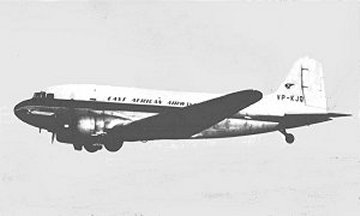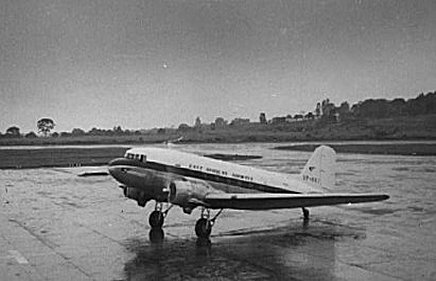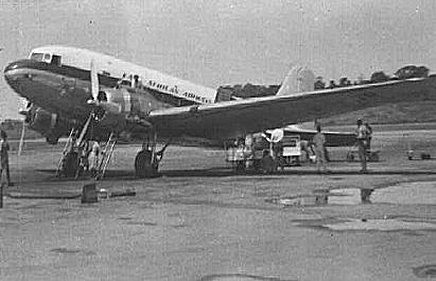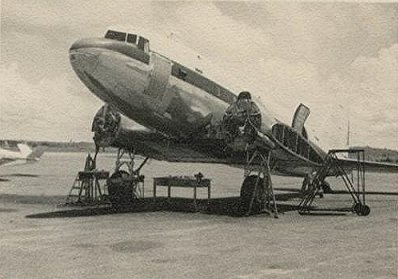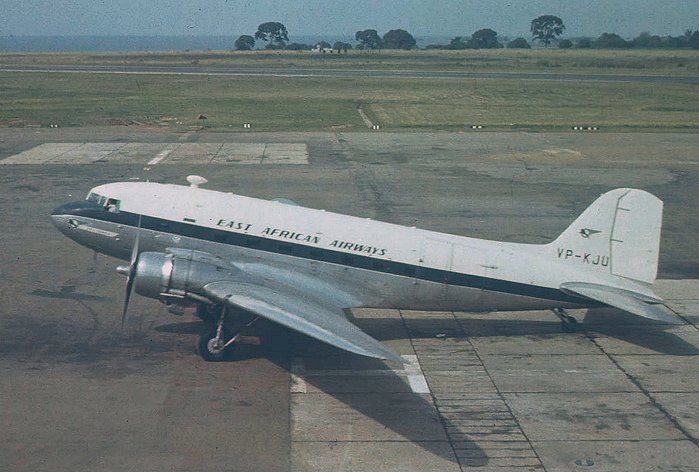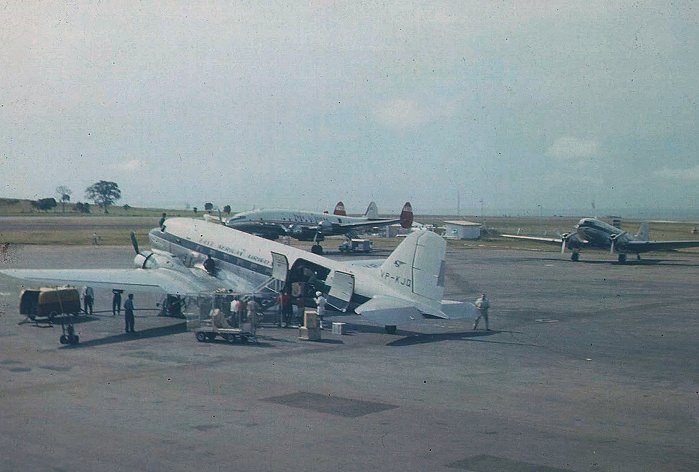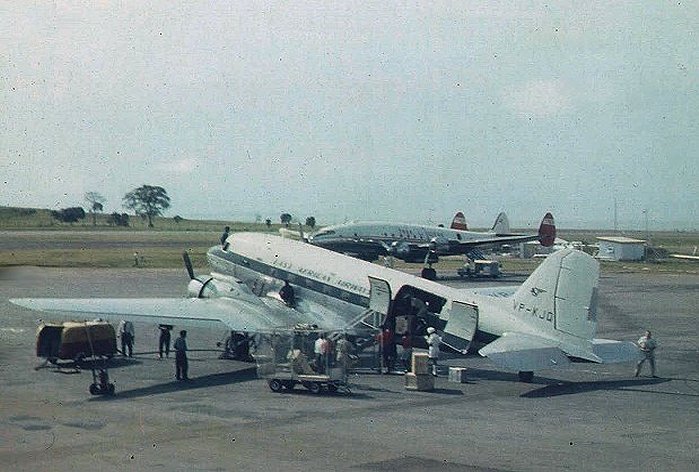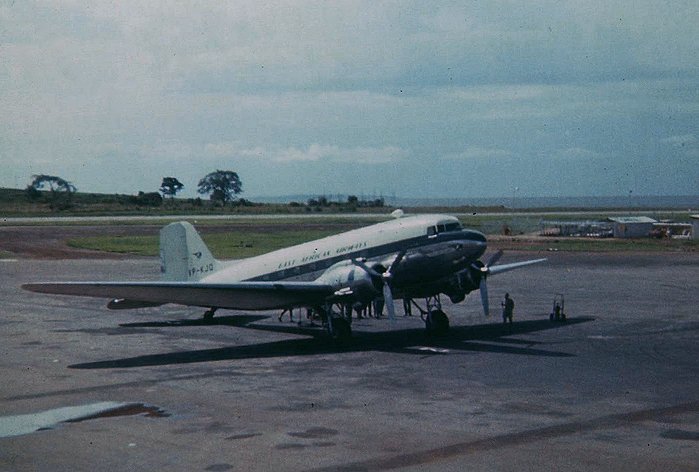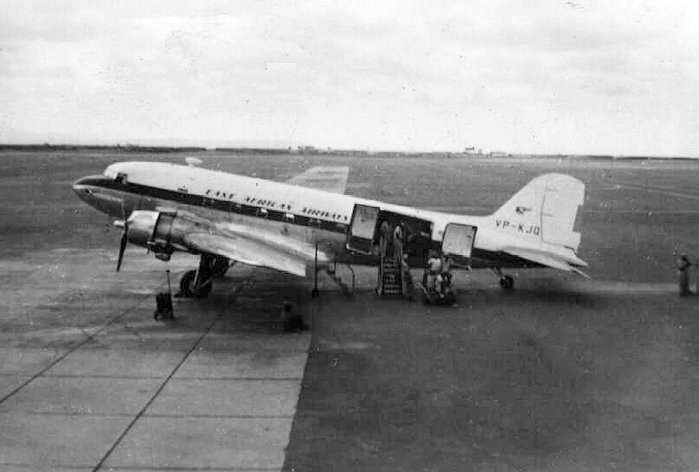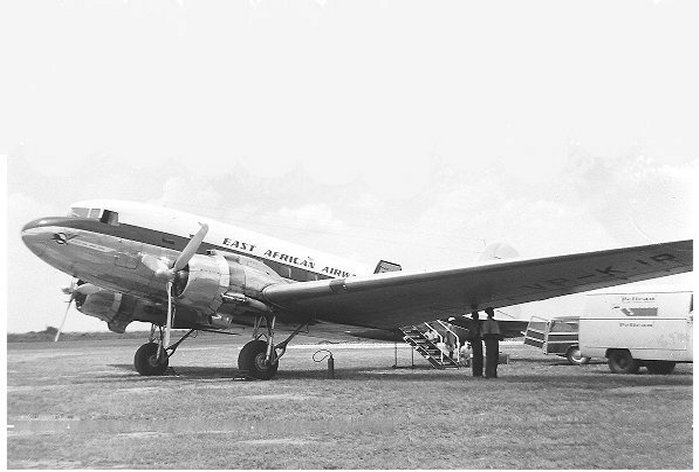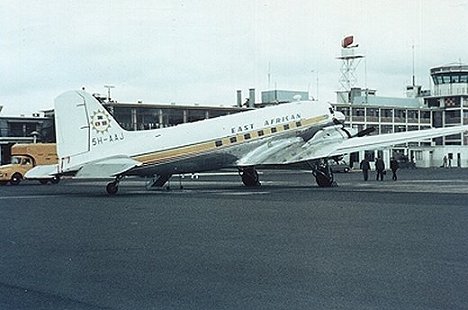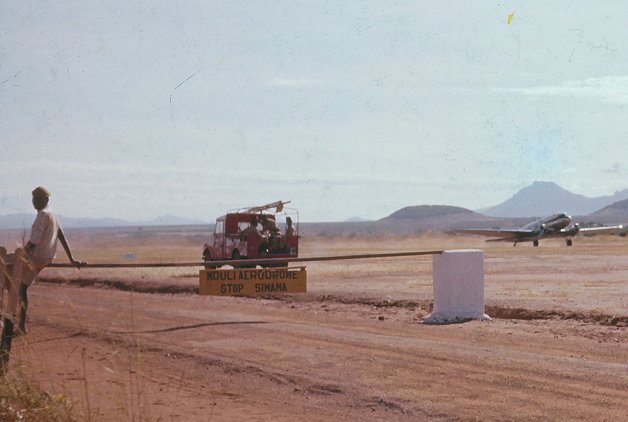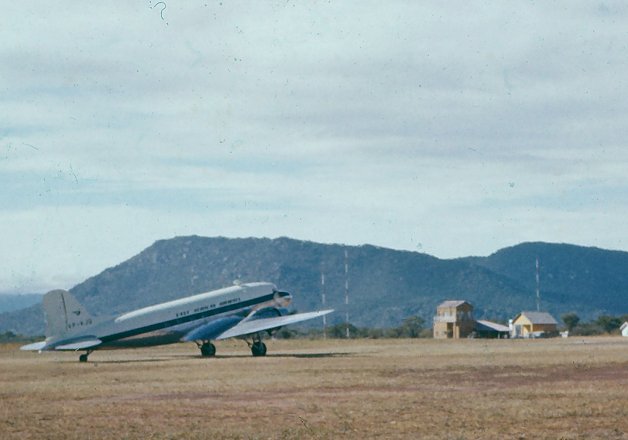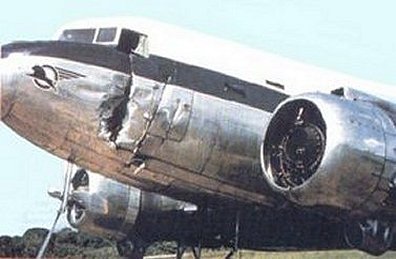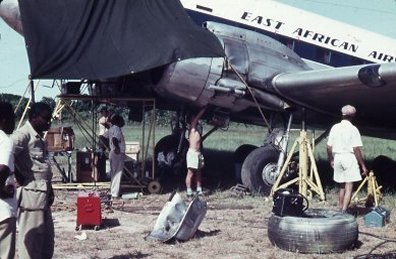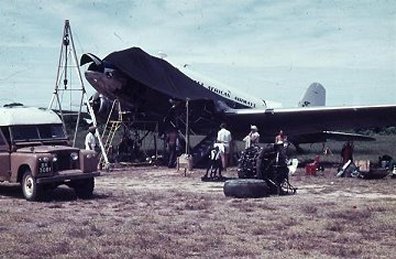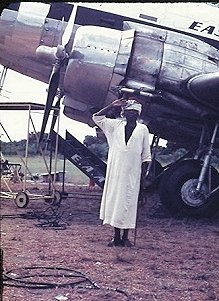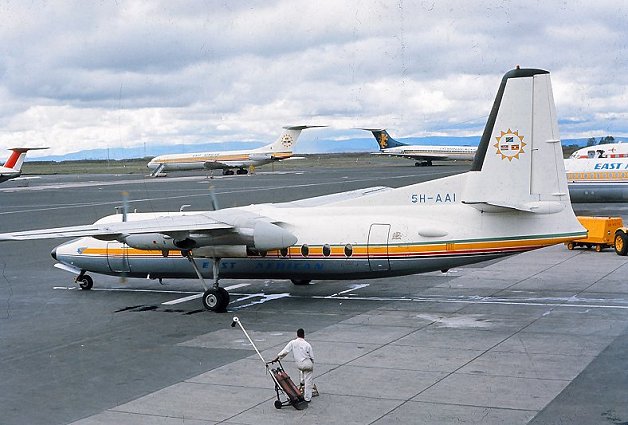|
|
||
|
C47B Douglas DC-3 Dakota |
||
|
|
The mainstay of the East African Airways fleet on the internal routes until the early 60s was the C47B. By 1961 direct internal flights between Nairobi and Entebbe were being operated with the Canadair 4s - ex-BOAC Argonauts which had been displaced from the international routes by the brand new de Havilland Comet 4s - VP-KPJ and VP-KPK. The Comets were soon augmented by a third - VP-KRL PHOTO (VP-KJQ) East African Airways. |
|
|
|
|
|
|
A DC3 (usually referred to by East African Airways as a C47B) arrives and departs Entebbe. PHOTOs Malcolm McCrow |
||
|
|
|
|
|
VP-KJR at Entebbe (left). One afternoon in 1959 a C47B VP-KJS (right) came to grief attempting take off on Entebbe's main runway. Several stories did the rounds as to what happened, but I never heard the definitive version. PHOTOs Malcolm McCrow |
||
|
|
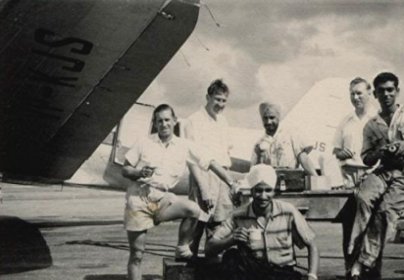 |
|
| After its mishap at Entebbe, VP-KJS was repaired there before being flown back to Nairobi - note the repair to the door aft of the flightdeck: there was always a danger of the port hand propeller "walking into the cockpit" - as it did some years later in the Kilwa incident - with tragic results - see below. Some years later Juliet Siera passed from East African Airways to the Suid-Afrikaanse Lugmag - South African Air Force. PHOTOs Ron Leese | ||
|
|
||
| DC3 VP-KJU (above) was called Sagana II and was used by the British Queen during her visit to Uganda in 1954. It was in the original Sagana (also a DC3) that the Queen flew from Nanyuki (Kenya) to Entebbe to board the Royal Argonaut in which she hurriedly flew back to London on the death of her father King George VI. Thus East African Airways became the first airline to carry a reigning British monarch. The aircraft is pictured at Entebbe. C47B (left) at Nairobi awaits departure for Entebbe via Kisumu and Jinja. PHOTO Malcolm McCrow | ||
|
|
||
|
DC3s at Entebbe in 1962 along with a Trek Lockheed Constellation. PHOTO Malcolm McCrow |
||
|
|
||
|
VP-KJQ loading for Nairobi. PHOTO Malcolm McCrow |
||
|
|
||
| VP-KJQ on another visit to Entebbe in 1960. PHOTO Malcolm McCrow | ||
|
|
||
|
VP-KJQ at Nairobi one Sunday afternoon in 1960. The aircraft ended up with the Suid-Afrikaanse Lugmag - South African Air Force - PHOTO Malcolm McCrow |
||
|
|
||
| DC3 VP-KJR at Kasese in Western Uganda. East African Airways operated from many grass strips around East Africa. PHOTO - Bret Langevad | ||
|
|
Tanzanian registered 5H-AAJ
(formerly VP-KLA) at Nairobi sporting the second and final East African Airways
livery. PHOTO - unkown photographer This aircraft eventually passed to Caspair who re-registered it in Kenya as 5Y-BBU
|
|
| The following three photographs below feature a rural strip in Tanzania in the late 1950s | ||
|
|
||
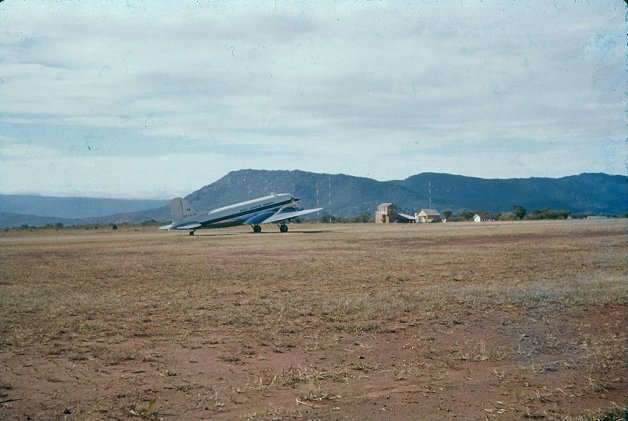 |
||
|
|
||
| VP-KJQ at Iringa, Tanganyika. The airport was called Nduli PHOTOs Geoff Pollard | ||
|
|
On 27 April 1964 C47B VP-KJP, whilst landing at Kilwa, left the runway. The wheels dug in to the soft ground bringing the aircraft to a sudden halt and causing the port propeller to contact the ground. It then flew off killing the pilot Captain Gene Brokensha - PHOTO (left) Ken Fuller. The First Officer was Tommy Turk whose detailed report is attached. The aircraft was temporarily repaired at Kilwa before being flown back to Nairobi. |
|
|
|
|
|
|
|
Like at Entebbe, the DC3 was again
temporarily repaired at the scene of the accident - and like at Entebbe this
necessitated filling in the for'a'd door. But Kilwa lacked the [limited] facilities that Entebbe had, where, if necessary, a hangar and heavy lift equipment was to hand. This aircraft too eventually entered service with the Suid-Afrikaanse Lugmag. PHOTOs - above and left - Ron Leese
|
|
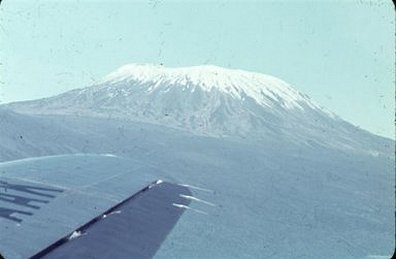 |
Kibo, one of Mount Kilimanjaro's
twin peaks, photographed by Les Leese from an aircraft returning to Nairobi from
Kilwa after the incident described above. Apart from the tragic loss of Super VC10 VP-UVA
at Addis Ababa on 18 April 1972, the only other East African Airways crash which
resulted in the loss of passenger lives occurred on 18 May 1955. C47B VP-KKH
was on
Flight EC 104 from Durban to Nairobi flew into Mwenzi, Mount Kilimanjaro's other
twin peak. The mountain, the highest in Africa, can be obscured for days. PHOTO - Ron Leese |
|
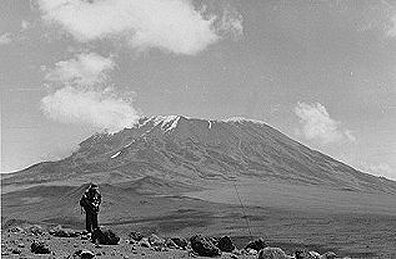 |
Kilimanjaro photographed in 1955 when the Mountain Club of Kenya
was on stand by to go to find the wreck
of VP-KKH. The wreckage was located on 22nd May at 15,200 ft.
Pilot error - the subsequent enquiry's deduced reason for the crash - was said
to have resulted from the captain's changing his route between Dar-es-salaam and
Nairobi, possibly due to bad weather. PHOTO - Kevin Patience |
|
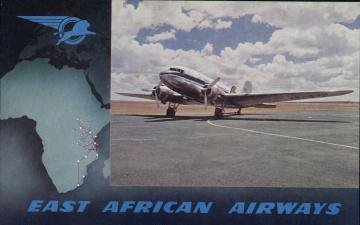 |
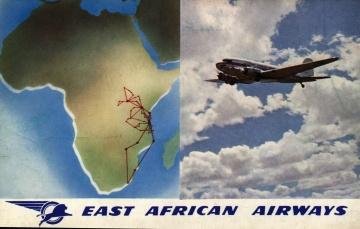 |
|
|
Postcards were available on the DC-3 international services to Rhodesia and South Africa in the early 1950s. By 1956 these postcards were part of the free publicity material on the East African Airways stand at the Highlands Show in Eldoret. |
||
|
Canadair C4 (DC4M2) Argonaut |
||
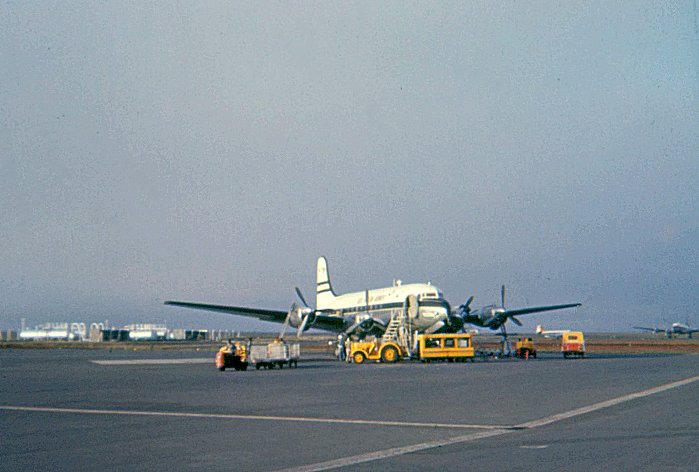 |
||
| Canadair 4 VP-KNY in 1961 photographed at Nairobi Embakasi on the ramp usually reserved for BOAC Britannias. Note the highly polished aluminium. Note also the second Canadair parked outside the EAA Maintenance Hangar, and the Heron used by the East African Civil Aviation Authority. PHOTO - Malcolm McCrow | ||
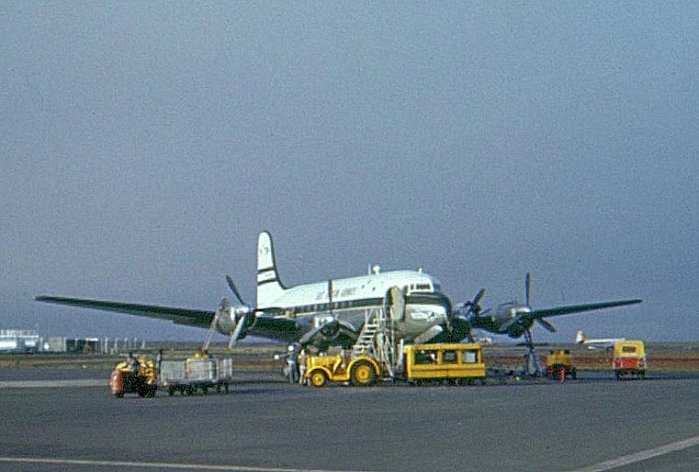 |
||
| The Argonauts were all but forced on East African Airways by major shareholder, BOAC, which was appalled at the thought of East African even contemplating buying from the US and firmly vetoed it. The Argonauts were not ideal for East African's routes and were to be a major source of trouble for the Airline. PHOTO Malcolm McCrow | ||
|
|
||
| East African Airways started a service to London in 1957 with ex-BOAC Argonauts which it termed Canadairs. This hybrid aircraft was actually a Canadair built Douglas DC-4 fitted with super-charged Rolls Royce Merlin engines and a pressurised cabin. The Rolls Royce in-line engines and the square windows of the Canadair Argonaut distinguished it from its otherwise similar DC-4. VP-KNY at Salisbury on one of East African Airway's international flights. PHOTO - Brian Robbins | ||
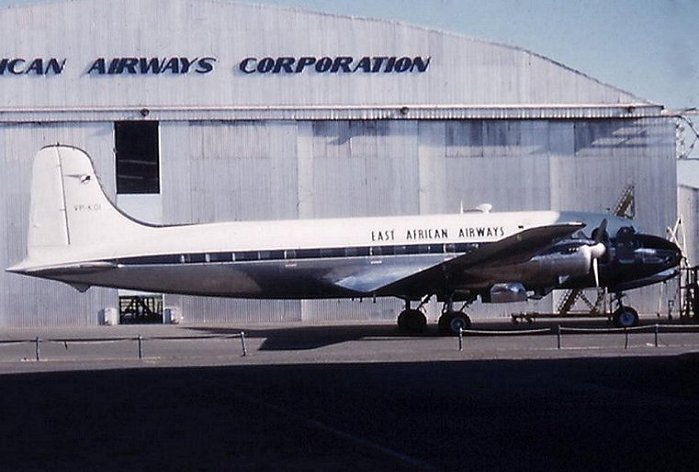 |
||
| Canadair VP-KOI in the later colour scheme for the Argonauts which mirrored that adopted for the C47Bs and Comets. Prior to this the Canadairs had retained the BOAC style white fin with a blue line above and below the registration letters and the British Union Flag on the rudder aft of the flying lion. PHOTO - Ron Leese | ||
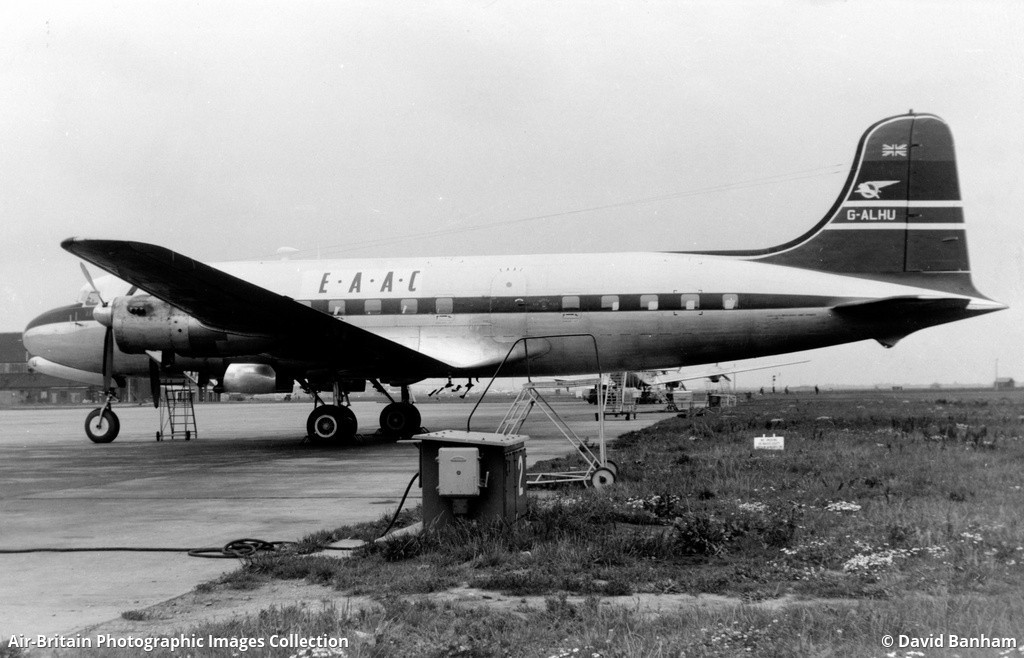 |
||
| "EA" has replaced "BO" on the fuselage and the East African Airways flying Lion has replaced the BOAC Speedbird on the blue tail fin. But the aircraft retains its British registration - G-ALHU - indicating the BOAC Argonaut on charter to East African Airways. It is seen at London Airport. The East African Airways Argonauts initially sported the original BOAC style white tail fin with the Speedbird replacing the Flying Lion. All bore Kenyan (VP-K) registrations and retained the British Union flag. Later the tail fins were painted all white with just the Flying Lion and Kenyan registration without the British flag as on the C47Bs. PHOTO David Banham | ||
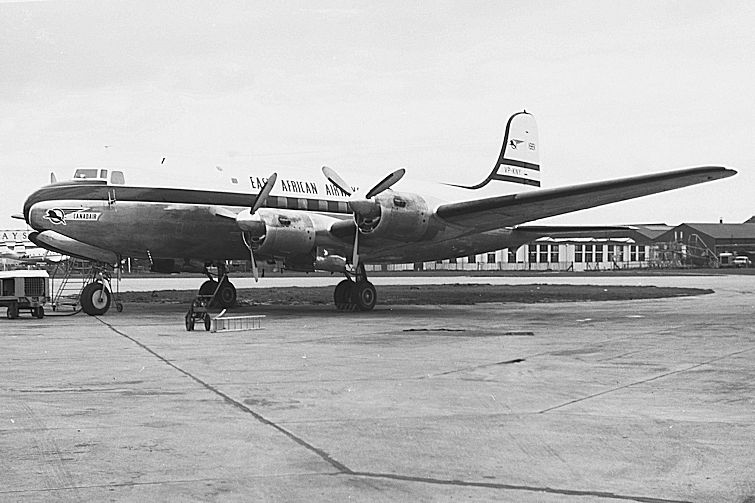 |
||
| VP-KNY at London Airport. East African Airways commenced its service between Nairobi and London in October 1957 using former BOAC Argonauts. Touch downs were made at Rome (Ciampino), Benghazi (Benina), Khartoum and Entebbe. The Argonaut was the fleet name given by BOAC to the Canadair DC4M2 or Canadair C4 which East African Airways referred to as the Canadair - PHOTO David Banham | ||
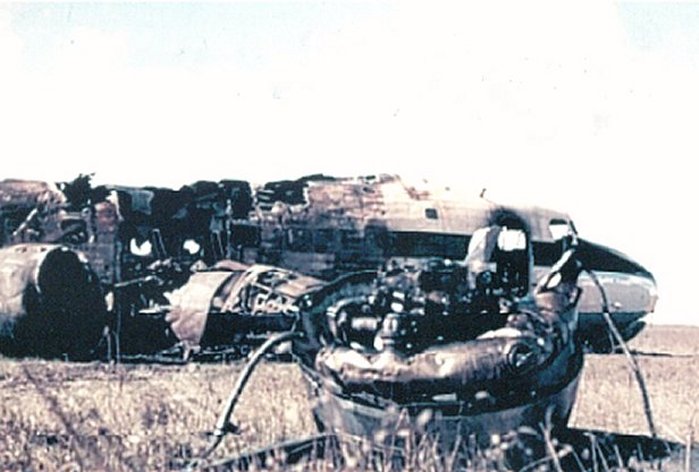 |
||
| The sad end of VP-KNY. On 11 April 1962 at Nairobi, Embakasi. The aircraft was on a training flight and lost power on take-off, sinking back on to Runway 06. With the undercarriage retracted, the propellers dug into the tarmac before the aircraft overshot and caught fire. There were no casualties. The crew abandoned the aircraft, the captain apparently urging the fire fighters to "let it burn" - the Argonaut was not the most popular aircraft in the fleet. PHOTO - Ken Fuller | ||
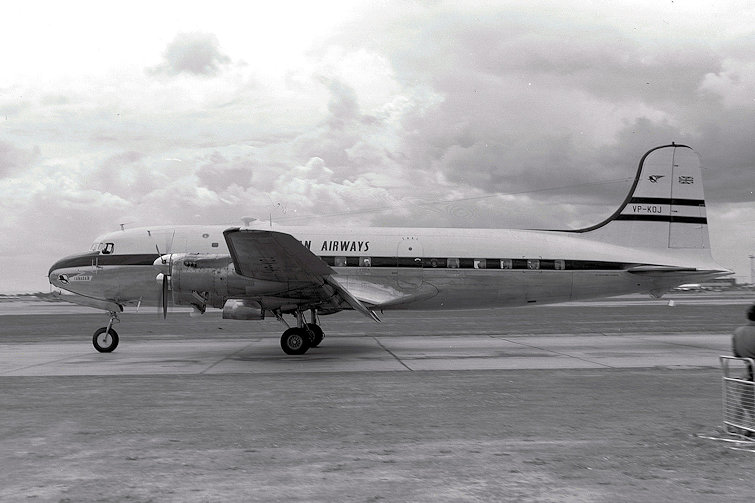 |
||
| East African Airways Canadair VP-KOJ taxies in on arrival at London Airport from Rome. Normal practice was to shut down the outer engines just before the aircraft touched the runway. - PHOTO David Banham | ||
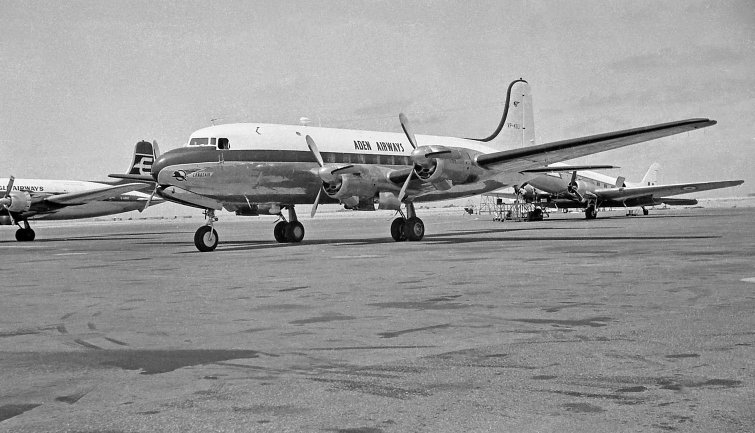 |
||
| The white tail fin and the Kenyan Registraion - VP-KOJ - (formerly G-ALHM) on East African Airways Canadair on charter to Aden Airways seen at Khormaksar accompanied by an RAF C47B Dakota and a British Eagle Airways DC6B. The Argonaut retains the East African Airways Flying Lion on the tail fin and on the nose and Aden Airways is printed in the East African Airways font. Whether or not the aircarft was ever purchased by Aden Airways is not known, but, according to "East African - an Airline Story" by Peter J Davis, it was sold by East African Airways to Britair (EA) Ltd and restored eventually to G-ALHM before being broken up at Redhill in 1966 The aircraft was broken up at Redhill in England in 1966. PHOTO Ray Deacon | ||
|
Bristol Britannia |
||
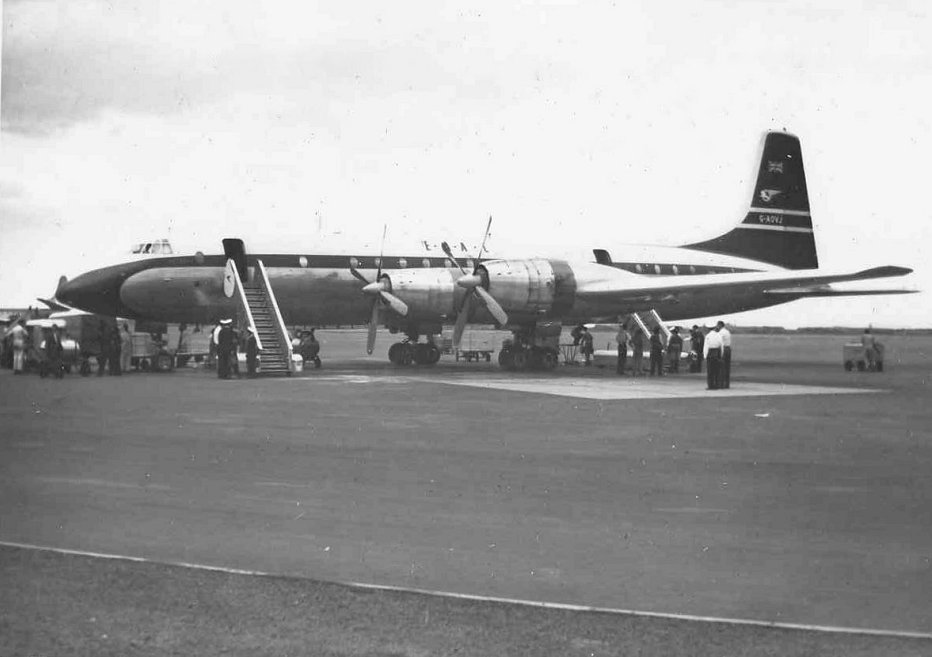 |
||
| A very rare photograph of an East African Airways Britannia 312 G-AOVJ on charter from BOAC seen at Nairobi Embakasi. In the late 1950s BOAC operated 312s to Nairobi but by 1960-61 had replaced them with the smaller 102. PHOTO Janet Davis | ||
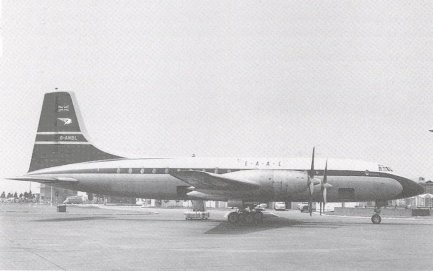 |
Seen at London Airport, Bristol Britannia 102 G-ANBL on charter to East African Airways: the Speedbird has been replaced on the fin with the Flying Lion and the letters EAAC have replaced BOAC on the fuselage. PHOTO - Air Britain | |
|
de Havilland Comet 4 |
||
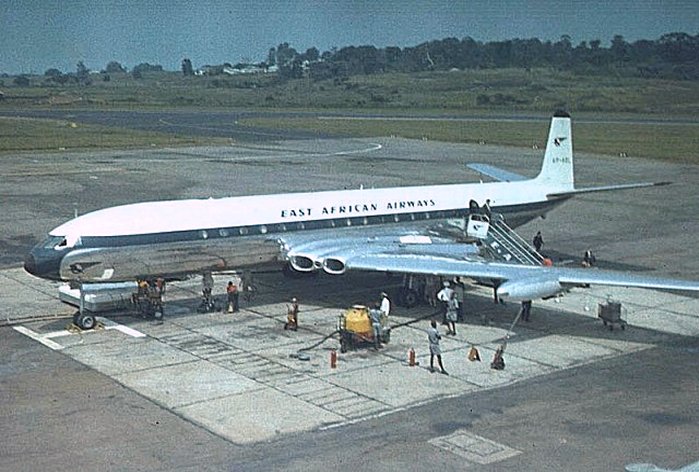 |
||
| The last Comet 4 to be ordered by East African Airways was VP-KRL seen here on the apron at Entebbe. However, it was not the last Comet 4 to enter service with East African Airways which chartered Comets from both BOAC and Danair, some of which appeared in East African livery and were registered temporarily in Kenya. PHOTO - Malcolm McCrow | ||
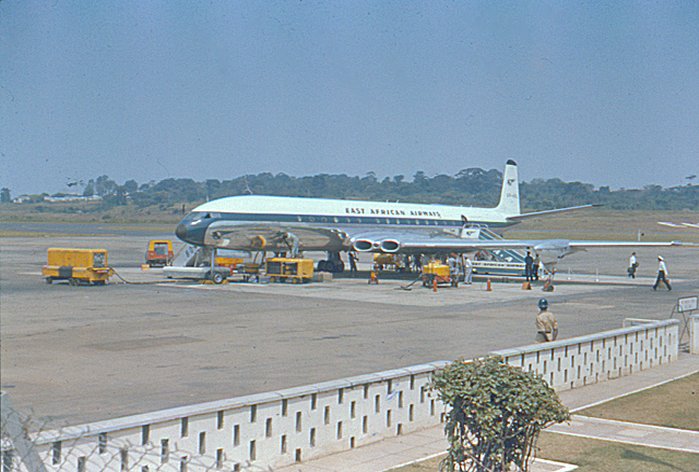 |
||
| In a bid to compete with BOAC and South African Airways, East African Airways initially purchased two new Comet 4s - VP-KPJ and VP-KPK. The two were soon augmented with a third - VP-KRL seen at Entebbe in 1962. PHOTO - Malcolm McCrow | ||
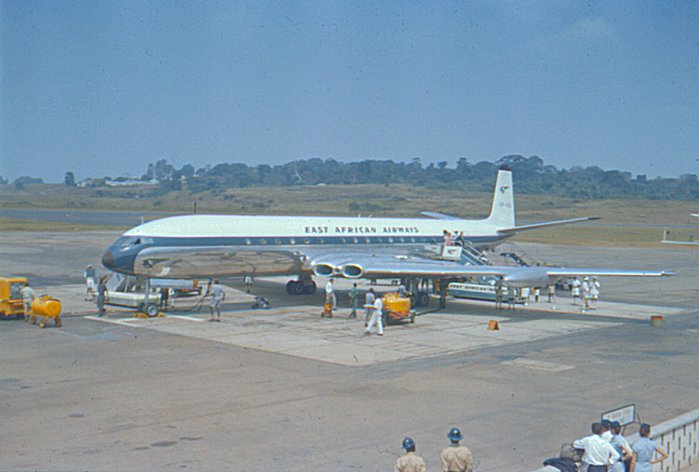 |
||
| VP-KRL at Entebbe. It has just arrived from London, Rome and Khartoum and will shortly depart for Nairobi. PHOTO - Malcolm McCrow | ||
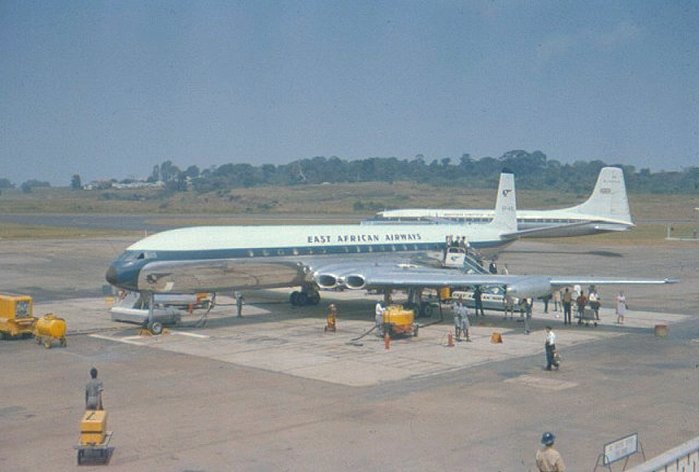 |
||
| The third Comet 4 - VP-KRL on the ramp at Entebbe in 1962. It is mid-morning and the Comet has just arrived from London. Shortly afterwards it is joined by a BUA Britannia 313 - also from London. PHOTO - Malcolm McCrow | ||
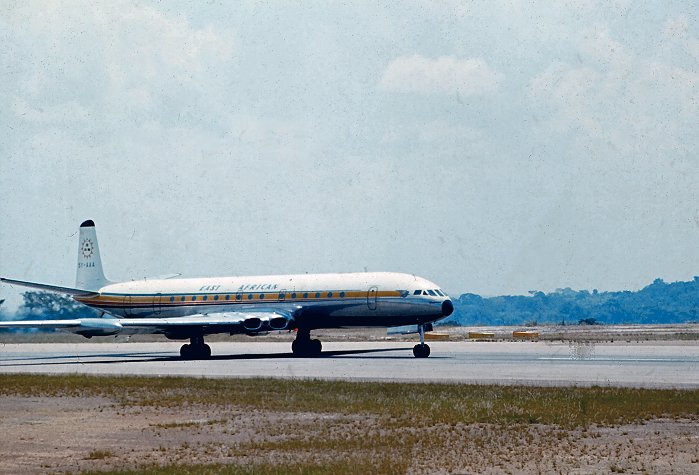 |
||
| Comet 4 5Y-AAA (originally VP-KRL, the third Comet to be delivered to East African Airways) has just backtracked and is lining up for take off on Entebbe's Runway 12 - PHOTO Geoff Pollard | ||
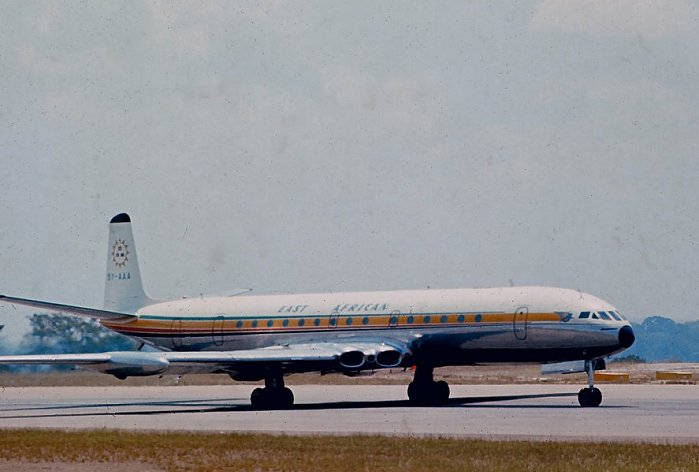 |
||
| At this point the Comet is hidden from the Control Tower and it will initially start its take off run up-hill before the runway dips towards the Lake - PHOTO Geoff Pollard | ||
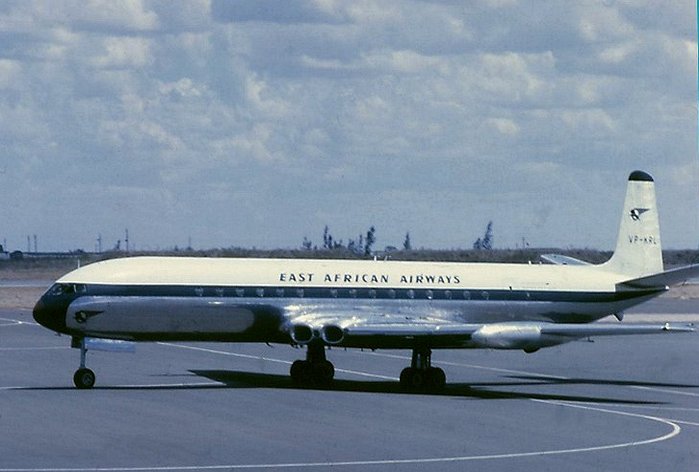 |
||
| VP-KRL taxis to the ramp at Nairobi Embakasi. The Comet 4 was to prove another "bad buy" forced on the Airline. It could not compete successfully on the main international routes on which competing airlines were soon to introduce the Boeing 707 and VC10. Nor was it suitable for the short haul inter-city flights between Dar-es-Salaam, Nairobi and Entebbe. On the latter routes it replaced the aging Argonauts. PHOTO Ron Leese | ||
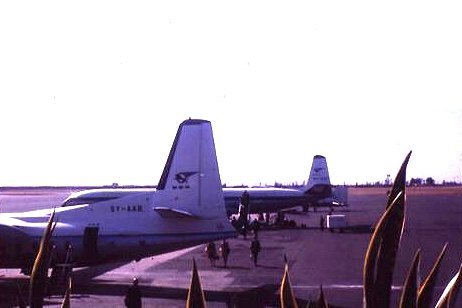 |
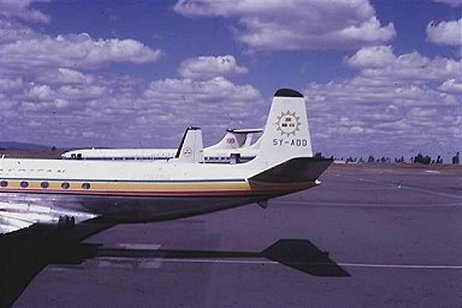 |
|
| Embakasi Line-ups. Still in their old livery - F27 5Y-AAB with Comet 4 behind (left). Reverse order - sunshine liveried Comet and East African Airways Fokker Friendship. The unmistakable fin of the VC-10 with its British flag belongs to British United Airways. Comet 5Y-ADD (G-APDL) was leased from BOAC from November 1965 to March 1967.PHOTOs - Ron Leese | ||
|
Fokker F27 Friendship |
||
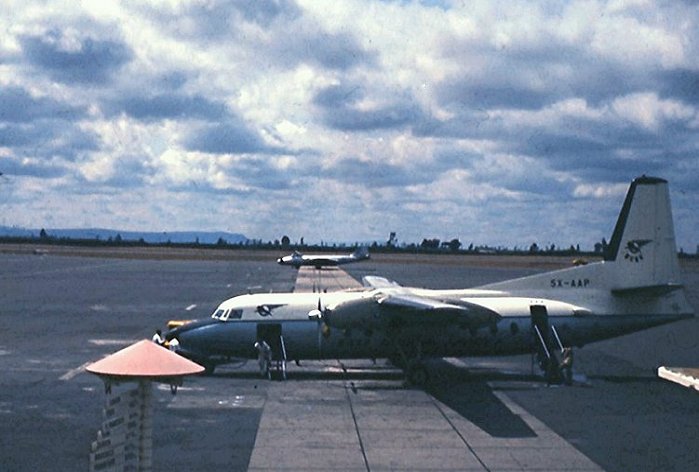 |
||
| 5XAAP at Nairobi. East African Airways operated three Friendships, the first entering service in November 1962. PHOTO - Ron Leese | ||
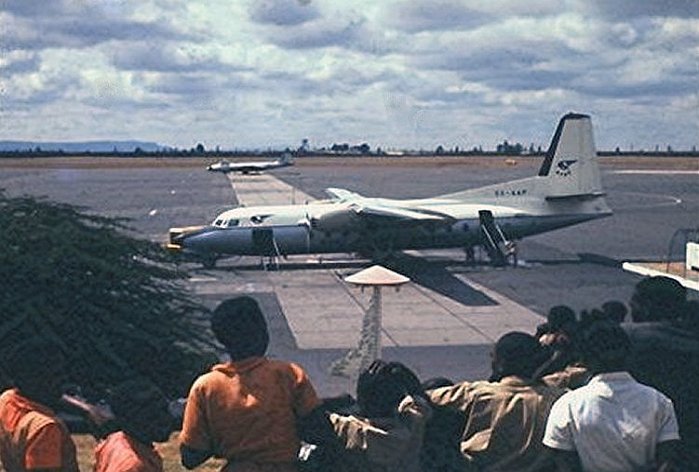 |
||
| East African Airways Fokker F27 Friendships were introduced in late 1962 - Ugandan Registered 5X-AAP (formerly VP-KTK) keeps an RAF Canberra company on Embakasi's deserted apron while excited school kids look on. PHOTO - Ron Leese | ||
|
|
||
| Fokker F27 Friendship, 5H-AAI at Embakasi. Other aircraft just visible include an East African Airways Super VC10, a British Caledonian VC10 an East African Airways DC 9 - PHOTO Geoff Pollard | ||
| Vickers (BAe) Super VC10 | ||
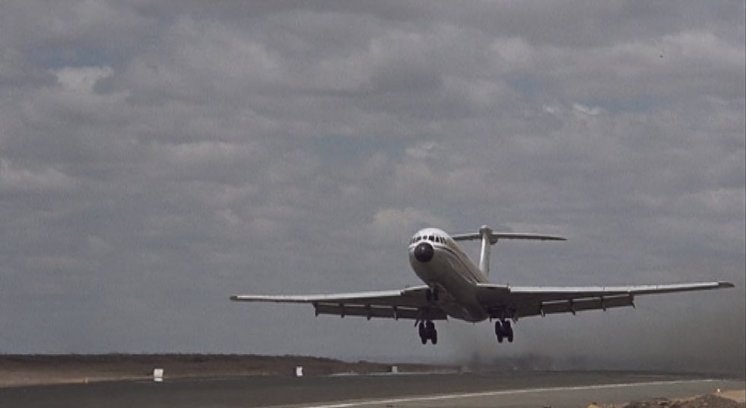 |
||
| East African Airways Super VC10 taking off from Nairobi in the film Living Free (Columbia ) VIDEO CAPTURE | ||
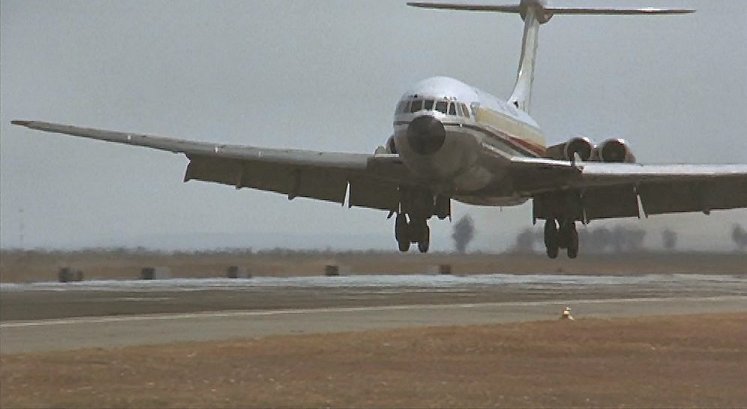 |
||
| East African Airways Super VC10 landing at Nairobi in the film Living Free (Columbia) VIDEO CAPTURE | ||
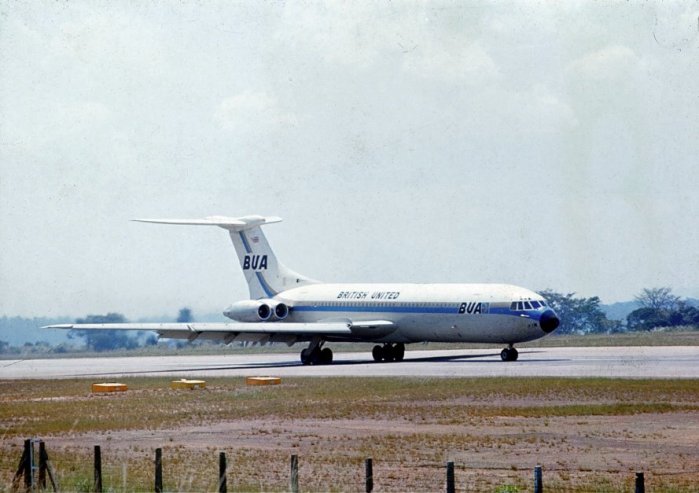 |
||
| Opposition at Entebbe as a BUA VC10 lines up for take off on Runway 12 - PHOTO Geoff Pollard | ||
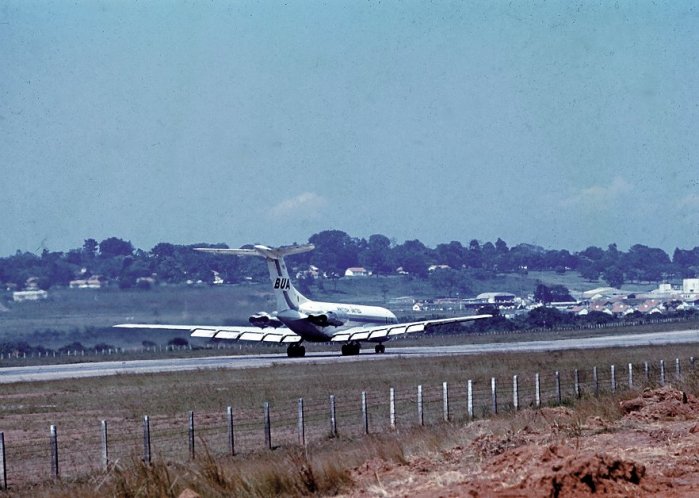 |
||
| The VC10 has just crested the hump on Runway 12 and is now hurtling downhill towards the Lake - PHOTO Geoff Pollard | ||
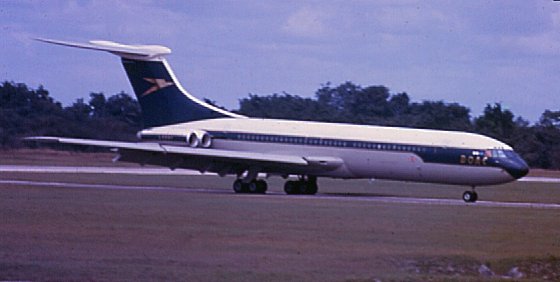 |
||
| BOAC only operated standard VC10s to East Africa. One is seen here at Dar-es-Salaam on its inaugural flight in the mid 1960s - PHOTO Bill Reeves | ||
 EAST AFRICAN AIRWAYS
EAST AFRICAN AIRWAYS